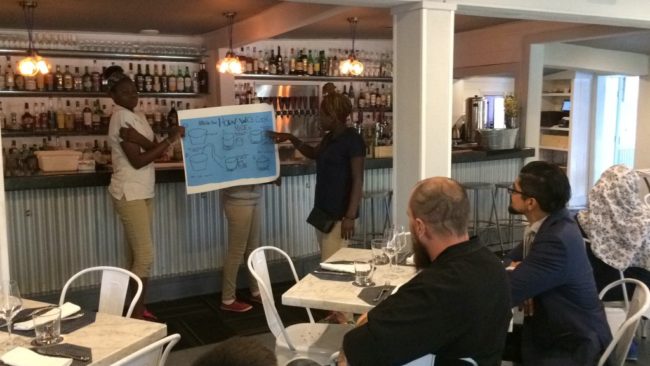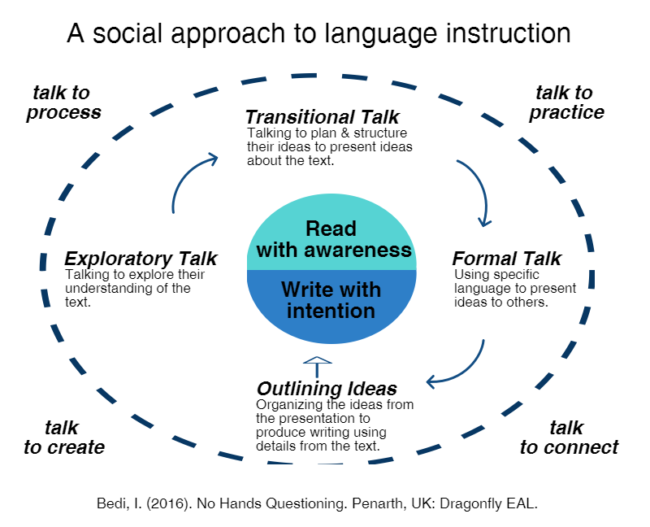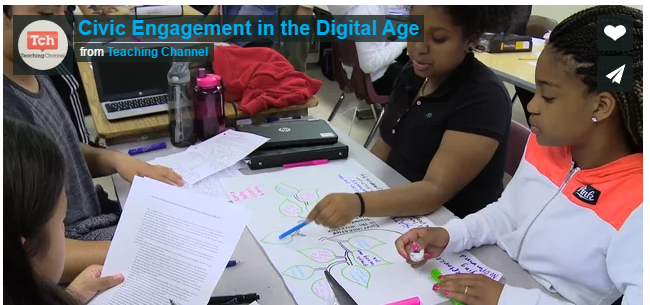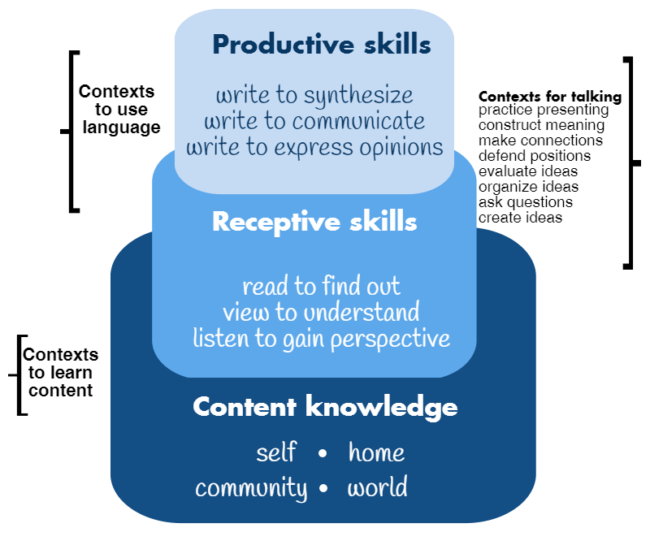Part 4 of WIDA’s Essential Action Series. Click here to return to the first article in the series.
I remember being pulled out of classes like English, art, music, and even my beloved gym class to attend an ESL class when I was in elementary school. It was a well-intentioned class, but it was also a poor substitute because I was learning language instead of using language in context. The content in my mainstream classroom could have been the context to develop my English language skills.
Creating a context for learning language is at the heart of Action 4 from WIDA’s Essential Actions: A Handbook for Implementing WIDA’s Framework for English Language Development Standards(Gottlieb, 2013). Gottlieb introduces this action by explaining that:
The explicit interaction between language and content is fundamental to the effective schooling of ELLs. Over the last several decades, there has been a growing recognition of the construct of academic language, referring to the unique discursive, grammatical, and vocabulary features that pertain to each academic discipline. Indeed, academic language is the common ground between language and content learning. Acknowledging and intentionally addressing content-area speci c language, in addition to social and instructional English, ensures that ELLs, like all students, have access to grade-level concepts throughout the school day (p.31).
This article explains how to set the content as the context to learn language. The goal of this post is to share case studies that exemplify how to link content with learning academic language.
Research
The following research points demonstrate that teachers can plan for ELs to learn content and language skills in tandem:
- Learning mainstream content and learning academic language are interrelated processes (Yore & Treagust, 2006; Yore, 2000).
- Teaching both content with academic language simultaneously can contribute to the academic achievement of ELs (Gottlieb, 2013; Echevarría, Vogt, & Short, 2008; Kaufman & Crandall, 2005; Chamot & O’Malley, 1994; Mohan, 1986).
- Mainstream classroom teachers can design units that integrate science, mathematics, or history content with academic language skills (Snow & Uccelli, 2009).
- Studies suggest that activities can be designed to address both language and content objectives if there is a systematic integration of language, content, and thinking skills (Short, Echevarría, & Richards-Tutor, 2011; Gibbons, 2008).
The research encourages educators to consider teaching language in context instead of in physically, emotionally, and intellectually isolating rooms removed from other students.
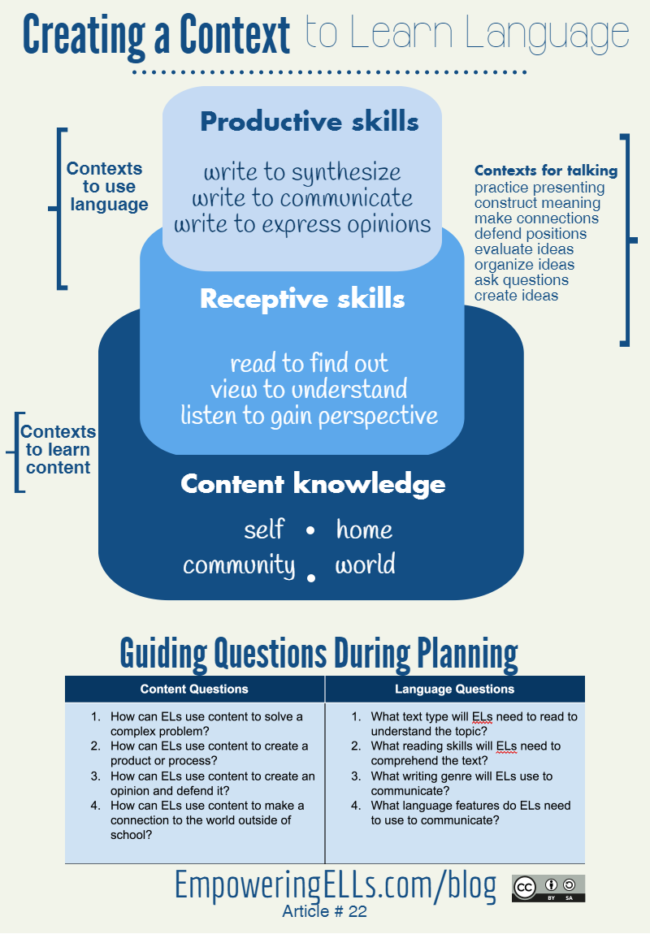
Case Study 1: Integrated Content
My colleagues and I are free to use any context in our lesson plans as long as we teach International Baccalaureate objectives and with a concept-based, inquiry-orient approach instruction. Therefore, I intentionally link my English course to my students’ science and history classes. The following section will provide real examples of how I integrated language objectives and academic content.
Science 7th Grade: Unit 1 (ecosystems)
Students learned about ecosystems, how they function, and how humans have affected them. Students researched another ecosystem not studied in the class and wrote a report describing humans’ impact on that ecosystem.
English 7th Grade: Unit 1 (ecosystems)
We studied coral reefs as an example of an ecosystem in English class to help students with their science research and simultaneously teach academic language. Students watched videos about coral reefs to identify details that are distinct to this ecosystem, read an article about what one scientist is doing to prevent the destruction of the coral reef ecosystem, and deconstructed the structure of an argumentative essay to help students write their science report (see Article # 11 to learn more about this process).
The example above demonstrates how I integrated the content from a science class to establish a context for learning language. In this unit, students developed their literacy skills as they watched non-fiction videos, read a challenging non-fiction text, wrote an argumentative essay, and talked throughout the unit to construct meaning of the shared texts.
This sheltered immersion model also scaffolded learning when my ELs went to science class. The resources viewed in English class and the discussions around those resources established a body of knowledge for the ELs when they attended their science class, where accessing the content and scaffolding for ELs isn’t the focus of the content teacher.
Case Study 2: Authentic Experiences
Carol Salva (one of my closest Twitter friends @MsSalvac) is a language specialist working at a Houston public school with a large newcomer population. Her students are 12-15 years old and many are developing their English skills. She writes about her experience of creating authentic learning opportunities to develop her ELs’ language skills in her blog.
Salva designed a science-related unit that also linked to entrepreneurship. Students were learning about heat transfer as the content, and Salva wanted to make the abstract concept more relevant. She grounded the concept in cooking and accepted an offer from The Durham House, a high-end Creole European restaurant, to support her efforts.
Salva and the restaurant owner decided to offer the students an opportunity to learn about the business and entrepreneurship and also capitalize on students’ interests. Some were interested in a cooking class, and many knew how to cook food from their home countries.
Salva guided her class on writing interview questions, practicing interview procedures, and learning how heat transfer is relevant to cooking. They would later present what they found to the restaurant.
Moreover, the restaurant owners also learned from students because they presented instructions on how to cook an African dish. Presenting their steps to the owner allowed the ELs to practice using cohesive devices such as first, then, and finally in their writing. Below is an image of the students presenting to the restaurant owner and head chef.
This unit also required students to think critically by making connections between the science content and how it affects the world outside of school. To help scaffold, Salva asked a native English students to present his Heat Transfer project to a few students who could relay the information to others. The presentation modeled an example of how academic language was used.
Throughout the unit, students moved from the informal register to formal register by practicing interview procedures, walking each other through procedures, and collaborating over how to structure the presentation to Durham House. Prepared speeches share the same formal register as academic writing language (Bedi, 2016). The mini-presentations and daily collaboration allowed ELs to use talk as performance, internalizing the formal language.
The image below illustrates how teachers can integrate different forms of talk to foster familiarity with formal language.
Case Study 3: Civic Engagement: Students as Change Agents
My final example comes from Matt Colley, an English and History teacher from Oakland Technical High School. He is charged with teaching students language skills and history content. However, he decided to make it more relevant. In his “Civil Engagement in the Digital Age Unit”, he didn’t just have students read, write, and talk about people that made significant changes in their communities. Colley went even further by empowering his students to advocate for a cause.
Colley went even further by empowering his students to advocate for a cause.
Students researched a social issue they cared about, identified contemporary manifestations of the problem, and analyzed the root causes of the issue. Then, students needed to plan actions they could take to address the problem. Some issues were LGBT rights, police brutality, military spending, women’s rights, Asian-American rights, access to healthy foods, and free speech.
Colley lead students through a process of identifying one manifestation they could address. They then started planning actions such as creating a petition, meeting with the mayor, and working with the school cafeteria to provide more access to healthier meals.
Consider watching Colley’s video and paying attention to the thinking, reading, writing, listening, and speaking that students produced while engaging with the unit. The students were engaged and lively because they intentionally applied the skills learned in a context that is personally meaningful.
Colley’s example inspires us to design learning experiences where ELs have a purpose for using language. The drive to use language is even stronger when the topics are related to ELs’ sociocultural experiences such as they were in Colley’s unit.
Applying Case Studies
These case studies exemplify learning experiences that use content to establish a context for learning language. Though these case studies take place in various contexts, they follow a similar framework of borrowing students’ experiences and interests as the context for using language. The graphic below illustrates this framework.
I find that there are at least four points of entry when considering the content: self, home, community, and world. We read texts and view videos related to these topics. The texts and videos build a body of knowledge around the topic. This body of knowledge enables ELs to write, to express their opinions, or to share thoughts related to the topic. Talking is integrated with the texts we read, multimedia texts we view, and the writing that students compose.
Guiding Questions While Planning
I use these guiding questions to design highly relevant units and learning experiences that are grounded in ELs’ experiences and interests. Notice how they’re not content specific, so they can be used across disciplines. The guiding questions are categorized as content or language questions.
This instructional approach asks ELs to be users of language instead of passive receivers. It facilitates learning so that students have to create using language. The skills and concepts become real and more easily internalized when ELs are using language skills to engage with content knowledge. Skills become transferable when they’re internalized. ELs become independent learners when they own a diverse set of transferable skills and conceptual understanding.
That’s really the goal of contextualizing learning within ELs’ interests and experiences: to engage students and promote achievement in both academia and the world.
Next Post
The next article will explain WIDA’s Action 5, which is the practice of differentiating language strategies based on ELs’ language development. I provide two frameworks to help you apply this principle in practice.
References
Bedi, I. (2016). Scaffolding Writing Across the Curriculum: An EAL approach. Penarth, UK: Dragonfly EAL.
Colangelo, L. L. (2016, May 28). Queens teachers use boats to teach ESL students STEM. Retrieved from http://www.nydailynews.com/new-york/education/hometown-heroes/queens-teachers-boats-teach-esl-students-stem-article-1.2653338
Chamot, A. U., & O’Malley, J. M. (1994). e CALLA handbook: Implementing the Cognitive Academic Language Learning Approach. Reading, MA: Addison-Wesley.
Echevarria, J., Vogt, M. E., & Short, D. J. (2008). Making content comprehensible for English learners: The SIOP® model (3rd ed.). Boston: Allyn and Bacon.
Gibbons, P. (2008). English learners academic literacy and thinking: Learning in the challenge zone. Portsmouth, NH: Heinemann.
Gottlieb, M. (2013). Essential Actions: A Handbook for Implementing WIDA’s Framework for English Language Development Standards. Madison: Board of Regents of the U of Wisconsin System.
Kaufman, D., & Crandall, J. (Eds.). (2005). Content-based instruction in primary and secondary school settings. Alexandria, VA: Teachers of English to Speakers of Other Languages.
Krashen, S. (1982). Principles and practices in second language acquisition. Oxford: Pergamon
Mohan, B. (1986). Language and content. Reading, MA: Addison-Wesley.
Short, D., Echevarría, J., & Richards-Tutor, C. (2011). Research on academic literacy development in sheltered instruction classrooms. Language Teaching Research, 15(3), 363–380.
Snow, C. E., & Uccelli, P. (2009). The challenge of academic language. In D. R. Olson & N. Torrance (Eds.), The Cambridge handbook of literacy. New York: Cambridge University Press.
Yore, L. D. (2000). Enhancing science literacy for all students with embedded reading instruction and writing-to-learn activities. Journal of Deaf Studies & Deaf Education, 5(1), 105–122.
Yore, L. D., & Treagust, D. F. (2006). Current realities and future possibilities: Language and science literacy – empowering research and informing instruction. International Journal of Science Education. 28(2/3), 291–314.

